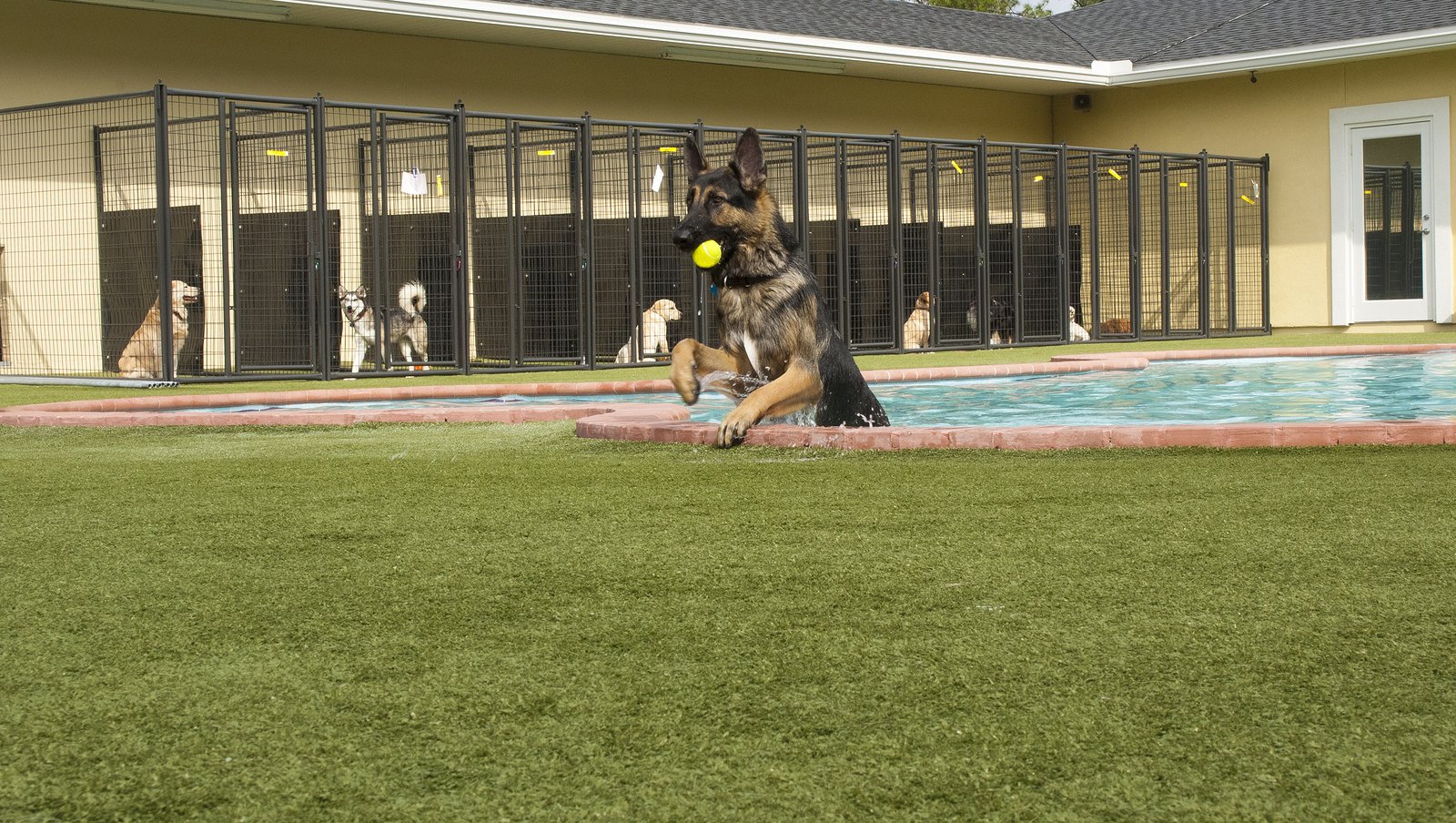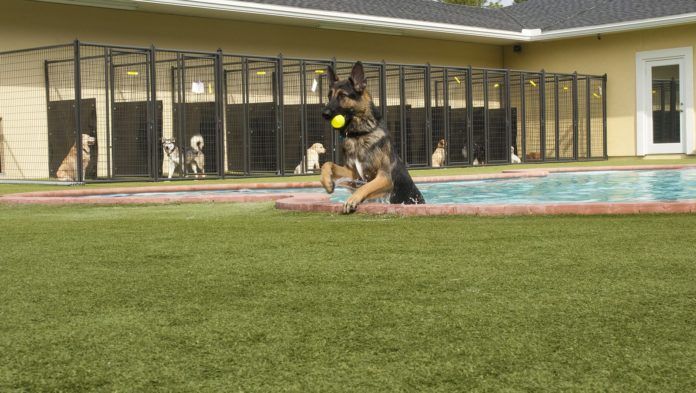
In the best of all possible worlds, if you have a dog at home, you will be home, too. Or a second dog will be there so the two can keep each other company. Granted, a lot of adult dogs can deal with the boredom, loneliness, and frustration of having no one to interact with all day, but it doesn’t mean they like it. And it certainly isn’t good for their physical or mental health to lie around with no outlet for their considerable energy or mental acuity and curiosity. As The Pets Hotel, an Australian doggie daycare business explains, dogs are not nocturnal animals. While they are naturally crepuscular, meaning that they have a penchant for activity at dawn and dusk, they also like to spend a fair amount of daylight hours engaged in physical activity and exploration and interaction with their environment — and with other living beings.
If you don’t have a second dog or a neighbor or family member who can take your dog into their home for the hours you’re away, doggie daycare makes a viable option. Your pet will be with others of his own kind, and he’ll be supervised by people who presumably will tend to his needs for a happy, healthy life while you’re at the office or tending to chores that keep you from paying enough attention to him. But the operative word here is “presumably.” Dogs have ended up dead at doggie daycare. We don’t mean to scare you but to make sure you don’t make the decision lightly. How do you choose the right daycare situation for your pooch? Since there’s no mandated accreditation for dog sitting enterprises, it’s a question you want to be asking yourself — and answering.
A good way to start is simply to get a feel for a place you are considering. Do the employees seem genuinely happy to be there? Do you get the sense that they really like dogs? Do the dogs seem happy, or nervous or glum around the staff? Also, does the place have a neutral odor, or is it unpleasant, as though it is not cleaned often enough or thoroughly enough?
You also want to find out whether someone is there at all times to supervise the dogs — and separate them should a problem break out. These are the things to determine at a very minimum.
Nuts and bolts
It’s a good idea to make sure dog groups are kept small. Some daycare facilities may be tempted to take in large groups of dogs to help meet their overhead and make a profit while doing so (fair enough), but too many dogs together means yours gets less attention. Also, some dogs become overstimulated and anxious in very large groups. They can’t get away, of course, which could make a dog miserable and, in some cases, aggressive.
What’s a good dog-to-person ratio? It depends to no small degree on the temperaments of the dogs in question. In general, the fewer dogs per person, the better. There are no federally required minimums, but some states have regulations of their own. Colorado, for instance, requires one staff person for every 15 dogs (which still sounds like a lot of dogs). At least one group also recommends a minimum of one staffer to 15 dogs although says that if it is an active group, 10 dogs to a person is better.
Speaking of groups, ascertain whether the dogs are divided by temperament rather than size. A tiny, scrappy terrier might not want to hang out with other little canines whose favorite pastime is sitting in someone’s lap; they may want to run with the big fellas. By the same token, an anxious German shepherd may need tender, quiet time with mellow sorts rather than raucous play. A daycare establishment should play it by a dog’s natural bent, not his brawn.
Then, too, while the purpose of doggie daycare is to keep your pet stimulated, make sure there are rest periods. A facility might advertise a fabulous outdoor agility gym for your dog to run around with others, but there also need to be opportunities — and spaces — for your pet to rest and regroup. Think about when a preschooler plays through nap time, too stimulated to realize he’s tired. His mood later in the day often isn’t pretty.
Of course, zero tolerance for counterproductive punishment techniques is critical. There can be no hitting, use of choke chains, or even yelling. All of those constitute abuse. If you get a sense that any infliction of pain or misery or fear is going on, pass up that establishment. It’s okay to go with your gut in the absence of proof. If something about the way the staff interacts with the dogs in its care just doesn’t feel right, don’t override your instinctual discomfort about what you’re sensing. Better to err on the side of safety.
Other questions to ask
Here are some more considerations for deciding which doggie day care establishment is the safest, and best, fit for your dog.
1. Is the staff trained to deal with dogs in any way? We don’t expect that people working at a canine daycare center are going to be veterinary behaviorists or even vet techs, but they should, at a minimum, be trained to understand canine body language and recognize signs of stress and also be able to handle basic animal care. If your dog needs medication while at the facility, staff members should be adept at administering it, whether topically, orally, or via injection (say, if the dog has diabetes and needs consistently timed shots of insulin).
2. Is the establishment comfortable letting you have a look around, including in the back, so you can get a sense of the accommodations? (Some places even have web access so that you can check on your dog from a distance at any time.) Is there a nice place for your pet to be able to rest and hang out when he doesn’t feel like interacting with his camp mates? Are there toys and other tools of environmental enrichment — perhaps a shallow splash pool in hot weather, for instance?
3. Is there an evacuation plan? The International Boarding & Pet Service Association points out that a positive answer to that question helps provide peace of mind and gives a sense of how on top of things the business is in general.
4. Are the premises adequately climate controlled — warm enough in winter, cool enough in summer? Are there shady spots and water outside in the hot-weather months?
5. Does the establishment do any temperament testing, even informally? It’s one thing for you to say what kind of personality your dog has — retiring, outgoing, etc. But the daycare staff should also want to see for itself, perhaps by judging at the start how easily your dog startles and how shy or game he feels around other dogs.
Once you choose a place
After you make a decision where to send your dog for the hours you’re not available to him, check his demeanor when you pick him up and bring him home. If he’s thrilled to see you, that’s all to the good. But if he’s got a “get me out of here” thing going on, frantically wanting to leave rather than just being excited to see you, it’s a red flag.
Once your dog is home, he should be tired but not exhausted as if he has just been to the front — or bullied all day by another dog, or dogs. Tired and ready for a cozy nap means he had a good, active time. Absolutely exhausted could signal that he feels very stressed at the facility or is somehow being put through more hoops than is good for him.
Finally, as comfortable as you might feel about the doggie daycare you have chosen, always keep your eyes and ears open. Staff turnover and other changes, such as the comings and goings of different dogs, can determine whether the place remains the right fit for your pet. It’s okay to move on if an establishment once served your dog’s needs but no longer does. Never let inertia get in the way of your pet’s well-being.





